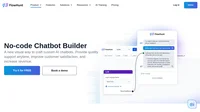What Is A Customer Service Chatbot
The Customer Service Chatbot is a tool that automatically interacts with customers and provides support through text conversations. It uses specific knowledge sources to give accurate and helpful answers. This setup is designed to improve customer support by offering quick, relevant responses based on your company’s information. You can explore more about customer service chatbots on FlowHunt.
Features Of A Customer Service Chatbot
- Knowledge Source Integration: Uses FAQs, product manuals, and support documents.
- Prompt Customization: Adjusts responses to fit your company’s needs. Learn more about customizing prompts here.
- Platform Integration: Works seamlessly with websites or customer service platforms.
- Automated Interaction: Engages users and gathers information efficiently.
- Regular Updates: Knowledge sources are updated to ensure accurate information.
Benefits Of A Customer Service Chatbot
- Quick Responses: Offers immediate answers to customer questions.
- 24/7 Availability: Operates all day, every day, improving customer support.
- Consistency: Provides standard responses using company-approved information.
- Efficiency: Reduces the workload on human agents by handling common questions.
- Scalability: Manages multiple questions at once without delay.
Why Use This Chatbot
Using a customer service chatbot can greatly enhance your customer support’s efficiency and effectiveness. It ensures customers get immediate and accurate responses, improving their experience with your brand. By automating routine questions, your support team can focus on more complex issues, optimizing resource use. A chatbot also ensures consistent communication, reducing human error and maintaining high-quality customer service. Discover how to create a chatbot with FlowHunt’s no-code builder.
Example Of Good And Bad AI Customer Service Interaction
Good Example
User Input:
“What is your return policy?”
Bot Output:
“Our return policy allows returns within 30 days of purchase. Please ensure the item is in its original condition and packaging. For more details, visit our returns page.”
Analysis:
The bot provides a clear, concise, and comprehensive response that directly addresses the user’s query. It includes specific details about the return policy, such as the time frame (30 days) and conditions (original condition and packaging). Additionally, it offers a call-to-action by directing the user to the returns page for more information, enhancing user engagement and satisfaction.
Key Takeaways
- Directly answers the user’s question with relevant details.
- Includes specific conditions and time frames, adding value to the response.
- Provides additional resources for the user to explore further information.
Bad Example
User Input:
“What is your return policy?”
Bot Output:
“Please refer to our website for details.”
Analysis:
This response is vague and unhelpful. It fails to provide any specific information about the return policy, leaving the user without a clear answer to their question. The response lacks engagement and may frustrate users who are seeking quick and direct answers to their inquiries. It misses the opportunity to guide the user to the exact information they need, reducing the chatbot’s effectiveness.
Key Takeaways
- Lacks specific information and clarity.
- Does not engage the user or provide useful guidance.
- Misses the opportunity to enhance user satisfaction by offering detailed responses.
Who can use the Customer Service Chatbot Flow
The Customer Service Chatbot flow on Flowhunt is ideal for businesses looking to enhance their customer support system. It is perfect for companies that require quick and relevant responses to customer inquiries, utilizing their organization’s specific knowledge. This tool is beneficial for those who can maintain an updated knowledge base, including FAQs, product manuals, and support documents. By integrating this chatbot into your platform or website, it ensures efficient customer service by retrieving information directly from configured sources. Regular updates to the knowledge base are crucial for optimal performance, making it suitable for dynamic and resource-rich environments.
Other Tools Similar To This Flow
- Dialogueflow: A Google tool for building conversational interfaces, including chatbots, that can integrate with various platforms. It’s known for its natural language processing capabilities and flexibility. Learn more about Dialogueflow.
- IBM Watson Assistant: An AI-powered chatbot platform that helps create conversational interfaces for various business needs. It offers easy integration with multiple channels and robust analytics features. Learn more about IBM Watson Assistant.
- Microsoft Bot Framework: This tool allows developers to build, test, and publish chatbots that can interact with users on different platforms. It provides a comprehensive framework for creating sophisticated conversational agents. Learn more about Microsoft Bot Framework.
- ChatBot.com: A user-friendly platform for creating chatbots that can be integrated into websites, social media, and messaging apps. It provides templates and an easy-to-use visual builder. Learn more about ChatBot.com.
- Zendesk Answer Bot: Part of Zendesk’s suite of customer support tools, this bot uses machine learning to automatically answer customer questions based on your knowledge base. Learn more about Zendesk Answer Bot.
- Tidio: A versatile live chat and chatbot solution designed for businesses looking to improve customer service and engagement on their websites. It supports AI-driven responses and seamless integration. Learn more about Tidio.
Each of these tools offers unique features and capabilities suited for different use cases and levels of complexity in managing customer service interactions.
AI-Agent-Powered Customer Service
Enhance customer support with FlowHunt's AI-agent. Automate inquiries, ensure swift resolutions, and boost satisfaction. Try free today!
Build Your AI Customer Service
Build custom AI chatbots with FlowHunt! Reflect your brand's voice, capture leads, and boost customer satisfaction. Try it free today!



